The Application of DIC Technique to Evaluate Residual Tensile Strength of Aluminum Alloy Plates with Multi-Site Damage of Collinear and Non-Collinear Cracks
Abstract
:1. Introduction
2. Experimental Program
2.1. Material and Specimens
2.2. Experimental Methods
2.2.1. Tensile Testing
2.2.2. DIC Analysis
2.3. Orthogonal Experiment Based on Strain Calculation Error
3. Results and Discussion
3.1. Orthogonal Experiment
3.2. DIC Strain Nephogram
3.3. Influence of Spacing between Adjacent Holes on RTS
3.4. Numerical Solution Based on the Net Section Yield Criterion
4. Conclusions
- (1)
- The influential order of the relevant factors for the strain calculation error is: subset size > interpolation tap > calibration score > step size. The optimal factor combination for strain calculation within our parameters is: 0.018 of calibration score, 23 pixels of subset size, step size is 1/4 of subset size, and the filter size of interpolation calibration is 8 pixels, its strain error is 35 micro-strains, which is better than the other factor combinations.
- (2)
- The existence of holes can decrease the RTS by 27.6% while the existence of cracks decreases the RTS by 21.7% for CC25 and 20.0% for NCC25. With the increase of spacing between adjacent holes in CC or NCC, the RTS of MSD specimens increases. The average RTS of NCC was higher than that of CC while L equals to 25 mm under the significance level of 0.05. As for the conditions of 21 and 29 mm, there were no actual differences between the average RTS of CC and NCC based on the statistical analysis.
- (3)
- The RTS calculation method based on the Net section yield criterion can give a conservative prediction value while the maximum computation error is 7.2%, which can be further used in the RTS evaluation of structure with MSD.
Author Contributions
Funding
Acknowledgments
Conflicts of Interest
Nomenclature
| Nomenclatures | Explanations |
| L | The spacing between adjacent holes |
| CC | The collinear cracked specimen |
| NCC | The non-collinear cracked specimen |
| CC21 | The collinear cracked specimen with spacing between adjacent holes of 21 mm |
| NCC21 | The non-collinear cracked specimen with spacing between adjacent holes of 21 mm |
| t | The static tension time |
| T | The total time until static tension failure |
| εy | The axial strain along the y direction |
References
- Sun, S.Q.; Zheng, Q.F.; Li, D.F.; Hu, S.Q.; Wen, J.G. Exfoliation corrosion of extruded 2024-T4 in the coastal environments in China. Corros. Sci. 2011, 53, 2527–2538. [Google Scholar] [CrossRef]
- Zhao, N.; Yang, Y.Q.; Han, M.; Luo, X.; Feng, G.H.; Zhang, R.J. Finite element analysis of pressure on 2024 aluminum alloy created during restricting expansion-deformation heat-treatment. Trans. Nonferr. Met. Soc. 2012, 22, 2226–2232. [Google Scholar] [CrossRef]
- Xu, Y.C.; Li, F.; Liu, X.; Yuan, S.J. Effects of pre-bulging on 2024 aluminum alloy complex-shaped components. JOM 2011, 63, 39–41. [Google Scholar] [CrossRef]
- Skorupa, A.; Skorupa, M. Multiple-site damage in riveted lap joints-experimental observations. In Riveted Lap Joints in Aircraft Fuselage; Gladwell, G.M.L., Ed.; Springer: Dordrecht, The Netherlands, 2012; Volume 189, pp. 207–240. [Google Scholar]
- Wang, X.; Modarres, M.; Hoffman, P. Analysis of crack interactions at adjacent holes and onset of multi-site fatigue damage in aging airframes. Int. J. Fract. 2009, 156, 155–163. [Google Scholar] [CrossRef]
- Silva, L.F.M.; Gonçalves, J.P.M.; Oliveira, F.M.F.; de Castro, P.M.S.T. Multiple-site damage in riveted lap-joints: experimental simulation and finite element prediction. Int. J. Fatigue 2000, 22, 319–338. [Google Scholar] [CrossRef]
- Jeong, D.Y.; Tong, P. Onset of multiple site damage and widespread fatigue damage in aging airplanes. Int. J. Fract. 1997, 85, 185–200. [Google Scholar] [CrossRef]
- Terada, H. Structural fatigue and joint degradation. Int. J. Fatigue 2001, 23, S21–S30. [Google Scholar] [CrossRef]
- Liao, M.; Shi, G.; Xiong, Y. Analytical methodology for predicting fatigue life distribution of fuselage splices. Int. J. Fatigue 2001, 23, S177–S185. [Google Scholar] [CrossRef]
- Liu, Y.M.; Mahadevan, S. Probabilistic fatigue life prediction using an equivalent initial flaw size distribution. Int. J. Fatigue 2009, 31, 476–487. [Google Scholar] [CrossRef]
- Renaud, G.; Liao, M.; Bombardier, Y. Development of an efficient methodology and tool to determine stress intensity correction factors for complex aircraft structures. In ICAF 2011 Structural Integrity: Influence of Efficiency and Green Imperatives, Proceedings of the 26th Symposium of the International Committee on Aeronautical Fatigue, Montreal, Canada, 1–3 June 2011; Komorowski, J., Ed.; Springer: Montreal, QC, Canada, 2011; pp. 335–345. [Google Scholar]
- Pan, B.; Yu, L.; Wu, D. Thermo-mechanical response of superalloy honeycomb sandwich panels subjected to non-steady thermal loading. Mater. Des. 2015, 88, 528–536. [Google Scholar] [CrossRef]
- Zhao, G.; Zhang, L.; Tang, C.; Zhou, Y.; Hao, W.; Luo, Y. Experimental study on the torsion behavior of a 3D 4-directionally braided composite shaft using DIC and AE. Polymer Test. 2018, 72, 122–131. [Google Scholar] [CrossRef]
- Tian, J.; Li, J.; Xie, H.; Yang, Y.; Kan, Q.H. Finite element implementation of a temperature-dependent cyclic plastic model for SA508-3 steel. Metals 2018, 8, 955. [Google Scholar] [CrossRef]
- Pazmino, J.; Carvelli, V.; Lomov, S.V.; Mieghem, B.V.; Lava, P. 3D digital image correlation measurements during shaping of a non-crimp 3D orthogonal woven E-glass reinforcement. Int. J. Mater. Form. 2014, 7, 439–446. [Google Scholar] [CrossRef]
- Sutton, M.A.; McNeill, S.R.; Jang, J.; Babai, M. Effects of subpixel image restoration on digital correlation error estimates. Opt. Eng. 1988, 27, 870–877. [Google Scholar] [CrossRef]
- Gustafson, H.; Siegmund, G.; Cripton, P. Comparison of strain rosettes and digital image correlation for measuring vertebral body strain. J. Biomech. Eng. 2016, 138, 054501. [Google Scholar] [CrossRef] [PubMed]
- Yoneyama, S.; Kikuta, H.; Kitagawa, A.; Kitamura, K. Lens distortion correction for digital image correlation by measuring rigid body displacement. Opt. Eng. 2006, 45, 023602. [Google Scholar] [CrossRef]
- Robert, L.; Nazaret, F.; Cutard, T.; Orteu, J.-J. Use of 3-D digital image correlation to characterize the mechanical behavior of a fiber reinforced refractory castable. Exp. Mech. 2007, 47, 761–773. [Google Scholar] [CrossRef]
- Pataky, G.J.; Sehitoglu, H. Experimental methodology for studying strain heterogeneity with microstructural data from high temperature deformation. Exp. Mech. 2015, 55, 53–63. [Google Scholar] [CrossRef]
- Guo, X.; Liang, J.; Tang, Z.; Cao, B.; Yu, M. High-temperature digital image correlation method for full-field deformation measurement captured with filters at 2600 °C using spraying to form speckle patterns. Opt. Eng. 2014, 53, 063101. [Google Scholar] [CrossRef]
- Orteu, J.-J.; Cutard, T.; Garcia, D.; Cailleux, E.; Robert, L. Application of stereovision to the mechanical characterisation of ceramic refractories reinforced with metallic fibres. Strain 2007, 43, 96–108. [Google Scholar] [CrossRef]
- Rajan, V.P.; Rossol, M.N.; Zok, F.W. Optimization of digital image correlation for high-resolution strain mapping of ceramic composites. Exp. Mech. 2012, 52, 1407–1421. [Google Scholar] [CrossRef]
- Wang, W.C.; Chiang, Y.A.; Yu, K.J.; Ho, Y.C.; Shen, H.T.; Chang, T.Y.; Chang, Y.H.; Tsao, C.S. Three-dimensional digital image correlation measurement of mechanical properties of soft materials. Meccanica 2015, 50, 419–428. [Google Scholar] [CrossRef]
- Härtel, M.; Illgen, C.; Frint, P.; Wagner, M.F.-X. On the PLC effect in a particle reinforced AA2017 alloy. Metals 2018, 8, 88. [Google Scholar] [CrossRef]
- Wang, F.; Cui, W.C.; Paik, J.K. Residual ultimate strength of structural members with multiple crack damage. Thin Wall. Struct. 2009, 47, 1439–1446. [Google Scholar] [CrossRef]
- Cherry, M.C.; Mall, S. Residual strength of unstiffened aluminum panels with multiple site damage. Eng. Fract. Mech. 1997, 57, 701–713. [Google Scholar] [CrossRef]
- Xu, W.; Wang, H.; Wu, X.; Zhang, X.; Bai, G.; Huang, X. A novel method for residual strength prediction for sheets with multiple site damage: Methodology and experimental validation. Int. J. Solids Struct. 2014, 51, 551–565. [Google Scholar] [CrossRef]
- Smith, B.L.; Saville, P.A.; Mouak, A.; Myose, R.Y. Strength of 2024-T3 aluminum panels with multiple site damage. J. Aircraft 2000, 37, 325–331. [Google Scholar] [CrossRef]
- Sumi, Y.; Yamamoto, Y. A Combined Analytical and Finite Element Method for Non-Collinear Crack Growth in Brittle Solids. In Discretization Methods in Structural Mechanics; International Union of Theoretical and Applied Mechanics (International Association for Computational Mechanics); Kuhn, G., Mang, H., Eds.; Springer: Berlin/Heidelberg, Germany, 1990; pp. 243–252. [Google Scholar]
- Chen, Y.; Sun, S.; Ji, C. Analysis of aluminum sheets with multiple sites damage based on fatigue tests and DIC technique. Int. J. Fatigue 2018, 109, 37–48. [Google Scholar] [CrossRef]
- Jones, R.; Molent, L.; Pitt, S. Study of multi-site damage of fuselage lap joints. Theor. Appl. Fract. Mec. 1999, 32, 81–100. [Google Scholar] [CrossRef]
- Seifi, R.; Ghadimian, O.; Ranjbaran, M. Study on life and path of fatigue cracks in multiple site damage plates. Int. J. Fatigue 2015, 80, 449–458. [Google Scholar] [CrossRef]
- Zhang, T.; Bao, R.; Lu, S.; Fei, B. Investigation of fatigue crack propagation mechanisms of branching crack in 2324-T39 aluminum alloy thin plates under cyclic loading spectrum. Int. J. Fatigue 2016, 82, 602–615. [Google Scholar] [CrossRef]
- Roy, R.K. Experimental Design Using Orthogonal Arrays. In Design of Experiments Using the Taguchi Approach: 16 Steps to Product and Process Improvement; John Wiley & Sons: New York, NY, USA, 2001; pp. 98–102. [Google Scholar]
- Yuan, Z.; Chen, X.; Zeng, H.; Wang, K.; Qiu, J. Identification of the elastic constant values for numerical simulation of high velocity impact on dyneema® woven fabrics using orthogonal experiments. Compos. Struct. 2018, 204, 178–191. [Google Scholar] [CrossRef]
- Wu, X.; Leung, D.Y. Optimization of biodiesel production from camelina oil using orthogonal experiment. Appl. Energy 2011, 88, 3615–3624. [Google Scholar] [CrossRef]
- Sutton, M.A.; Orteu, J.-J.; Schreier, H.W. Image matching methods. In Image Correlation for Shape, Motion and Deformation Measurements; Springer: New York, NY, USA, 2009; pp. 103–113. [Google Scholar]
- He, Z.H.; Sutton, M.A.; Ranson, W.F.; Peters, W.H. Two-dimensional fluid-velocity measurements by use of digital-speckle correlation techniques. Exp. Mech. 1984, 24, 117–121. [Google Scholar] [CrossRef]
- Peuchot, B. Camera virtual equivalent model 0.01 pixel detectors. Comput. Med. Image Grap. 1993, 17, 289–294. [Google Scholar] [CrossRef]
- Pook, L. Fatigue life in the presence of a crack. In Metal Fatigue; Gladwell, G.M.L., Ed.; Springer: Dordrecht, The Netherlands, 2007; Volume 145, pp. 135–159. [Google Scholar]
- Ribeiro, R.L.; Hill, M.R. Residual stress from cold expansion of fastener holes: measurement, eigenstrain, and process finite element modeling. J. Eng. Mater. Technol. 2017, 139, 041012. [Google Scholar] [CrossRef]
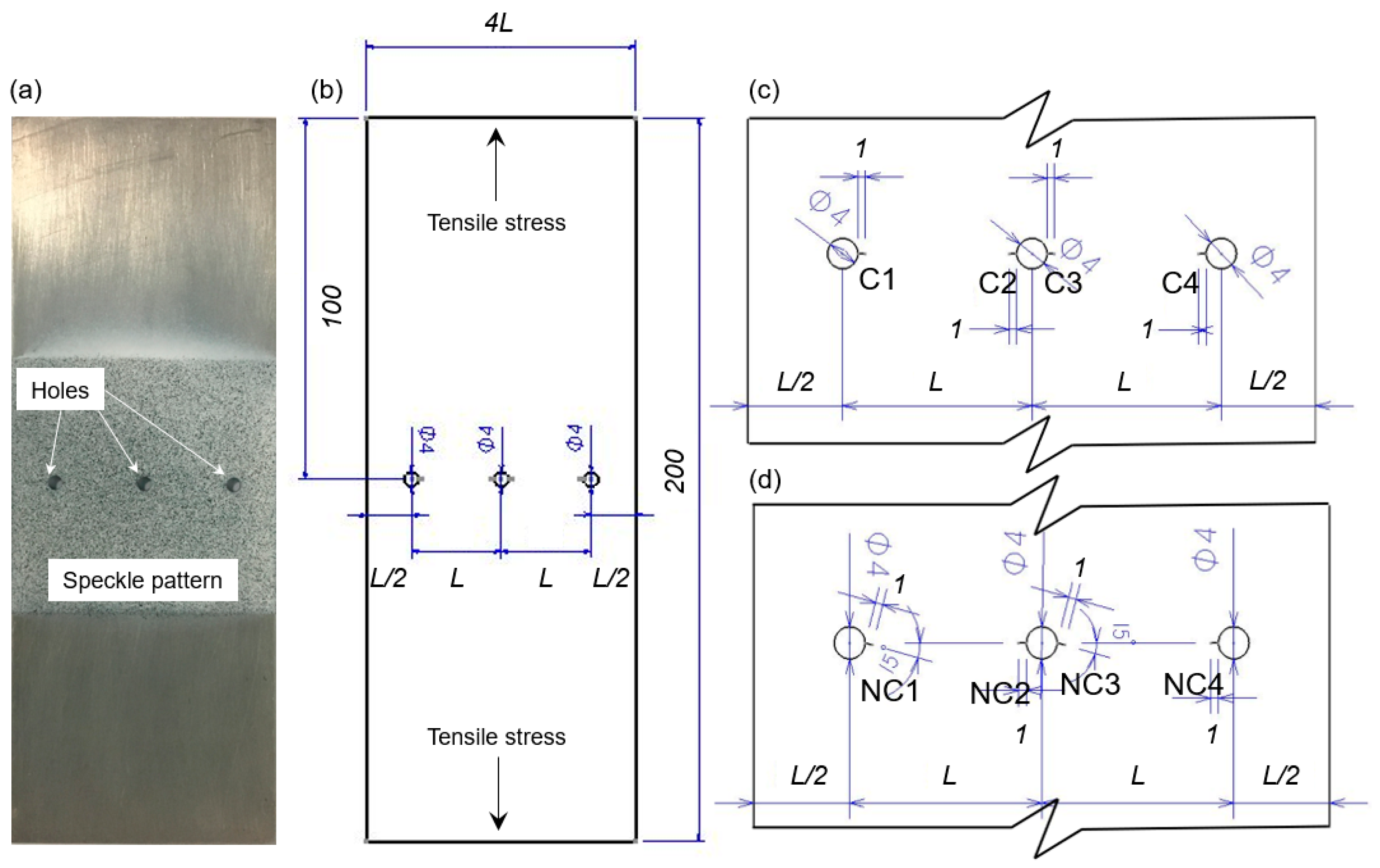
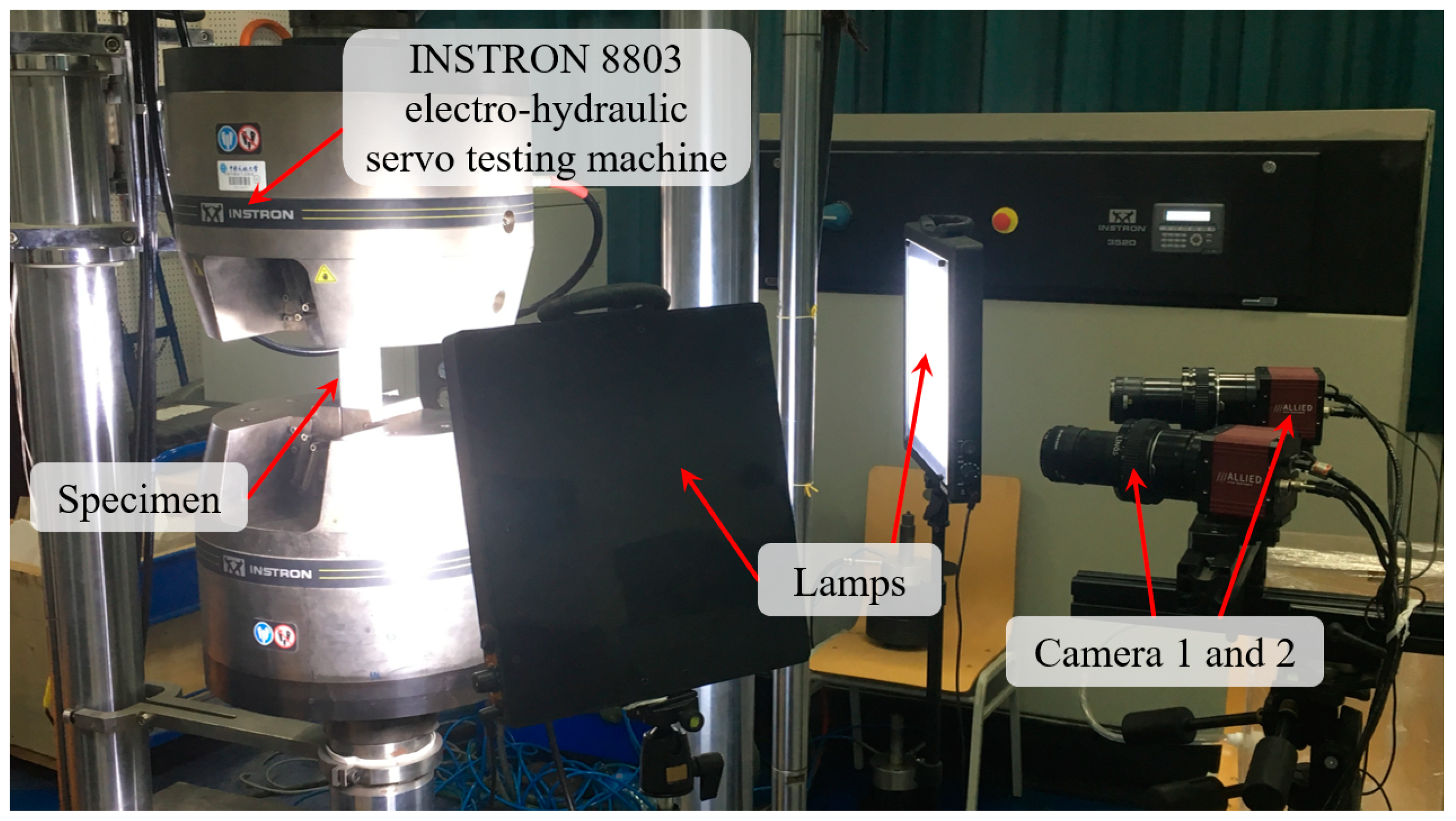
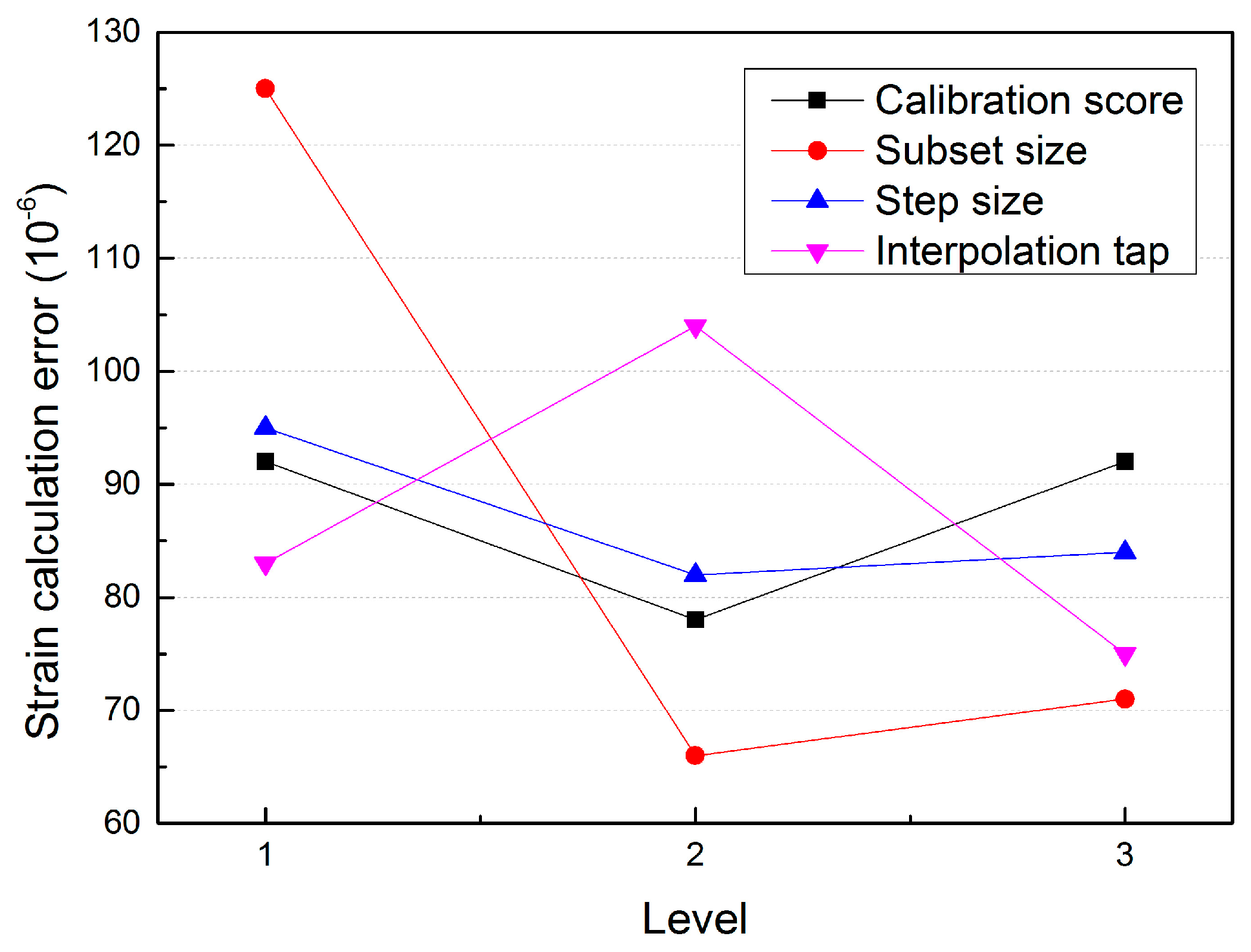
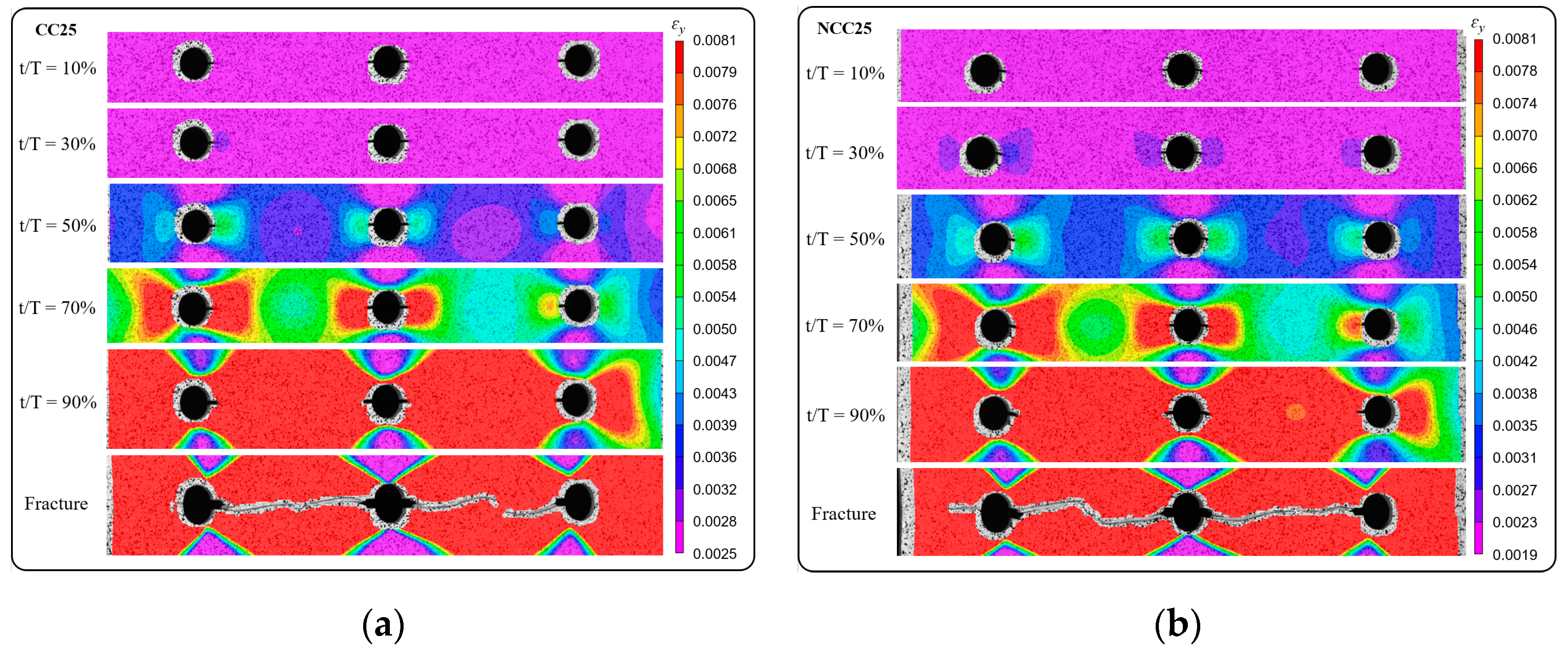
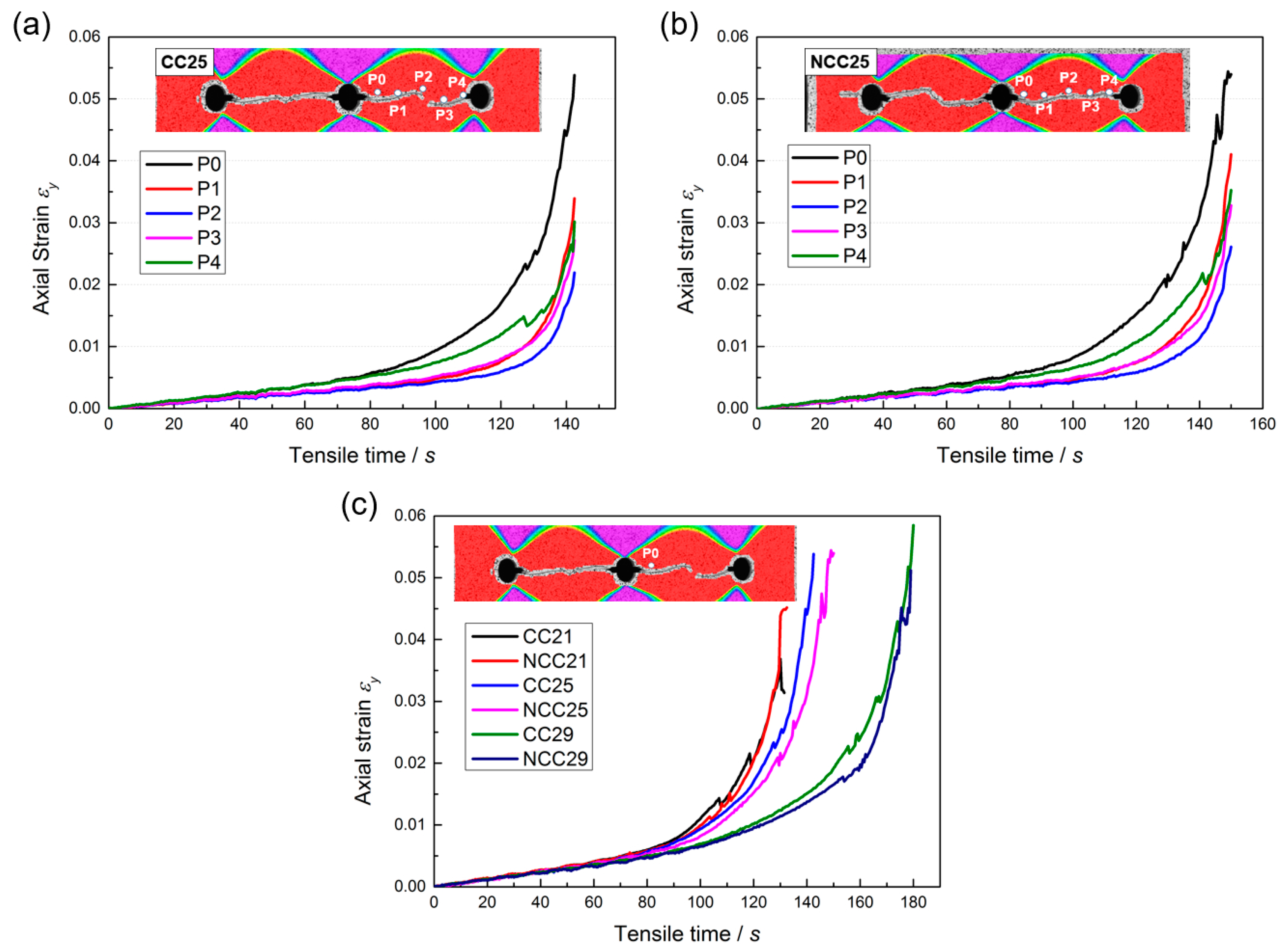

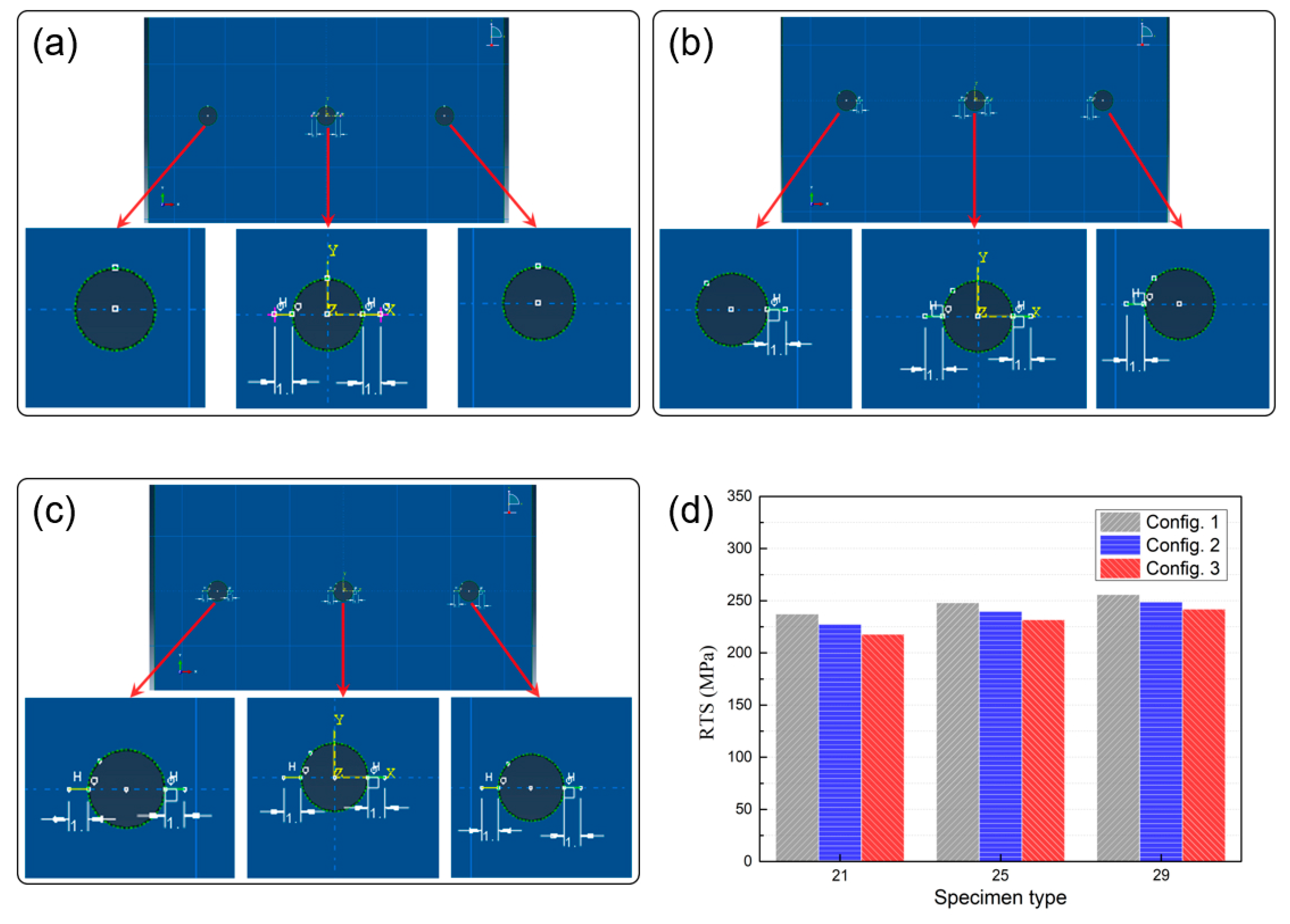
| Level | Calibration Score | Subset Size/Pixel | Step Size | Interpolation Tap/Pixel |
|---|---|---|---|---|
| 1 | 0.106 | 15 | 1/2 subset size | 4 |
| 2 | 0.018 | 23 | 1/4 subset size | 6 |
| 3 | 0.012 | 35 | 1/6 subset size | 8 |
| Experiment Number | Calibration Score | Subset Size/Pixel | Step Size | Interpolation Tap/Pixel | Strain Error/10−6 |
|---|---|---|---|---|---|
| 1 | 0.106 | 15 | 1/2 subset size | 4 | 133 |
| 2 | 0.106 | 23 | 1/4 subset size | 6 | 82 |
| 3 | 0.106 | 35 | 1/6 subset size | 8 | 60 |
| 4 | 0.018 | 15 | 1/4 subset size | 8 | 99 |
| 5 | 0.018 | 23 | 1/6 subset size | 4 | 49 |
| 6 | 0.018 | 35 | 1/2 subset size | 6 | 86 |
| 7 | 0.012 | 15 | 1/6 subset size | 6 | 143 |
| 8 | 0.012 | 23 | 1/2 subset size | 8 | 67 |
| 9 | 0.012 | 35 | 1/4 subset size | 4 | 66 |
| Items | Calibration Score | Subset Size/Pixel | Step Size | Interpolation Tap/Pixel |
|---|---|---|---|---|
| K1 | 275 | 375 | 286 | 248 |
| K2 | 233 | 197 | 246 | 311 |
| K3 | 276 | 212 | 252 | 225 |
| k1 | 92 | 125 | 95 | 83 |
| k2 | 78 | 66 | 82 | 104 |
| k3 | 92 | 71 | 84 | 75 |
| Δk | 14 | 59 | 13 | 29 |
© 2019 by the authors. Licensee MDPI, Basel, Switzerland. This article is an open access article distributed under the terms and conditions of the Creative Commons Attribution (CC BY) license (http://creativecommons.org/licenses/by/4.0/).
Share and Cite
Chen, Y.; Ji, C.; Zhang, C.; Sun, S. The Application of DIC Technique to Evaluate Residual Tensile Strength of Aluminum Alloy Plates with Multi-Site Damage of Collinear and Non-Collinear Cracks. Metals 2019, 9, 118. https://doi.org/10.3390/met9020118
Chen Y, Ji C, Zhang C, Sun S. The Application of DIC Technique to Evaluate Residual Tensile Strength of Aluminum Alloy Plates with Multi-Site Damage of Collinear and Non-Collinear Cracks. Metals. 2019; 9(2):118. https://doi.org/10.3390/met9020118
Chicago/Turabian StyleChen, Yajun, Chunming Ji, Changtian Zhang, and Shengjie Sun. 2019. "The Application of DIC Technique to Evaluate Residual Tensile Strength of Aluminum Alloy Plates with Multi-Site Damage of Collinear and Non-Collinear Cracks" Metals 9, no. 2: 118. https://doi.org/10.3390/met9020118
APA StyleChen, Y., Ji, C., Zhang, C., & Sun, S. (2019). The Application of DIC Technique to Evaluate Residual Tensile Strength of Aluminum Alloy Plates with Multi-Site Damage of Collinear and Non-Collinear Cracks. Metals, 9(2), 118. https://doi.org/10.3390/met9020118







